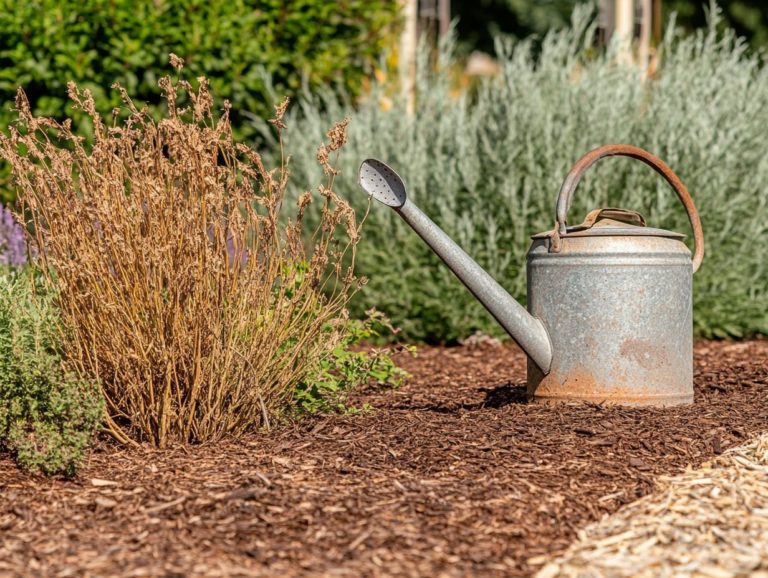What Is Companion Planting for Drought-Resistant Gardening?
Companion planting is a smart gardening method that pairs plants, including various companion species and herb varieties, to optimize benefits like water conservation and natural pest control. This makes it a perfect strategy for drought-resistant gardening.
By carefully selecting plant combinations, you can enhance your garden s resilience while minimizing the need for excessive watering.
Let s explore the essentials of companion planting together, providing tips on choosing the right compatible plants, identifying successful pairings, and implementing best practices.
Uncover the secrets to cultivating a thriving, sustainable garden that flourishes even in dry conditions.
Contents
- Key Takeaways:
- Benefits of Companion Planting for Drought-Resistant Gardening
- How to Choose Companion Plants
- Examples of Companion Planting Combinations
- Tips for Implementing Companion Planting in Your Garden
- Frequently Asked Questions
- What Is Companion Planting for Drought-Resistant Gardening?
- How Does Companion Planting Help with Drought-Resistant Gardening?
- What Are Some Examples of Companion Plants for Drought-Resistant Gardening?
- Can Companion Planting Be Used for Any Type of Garden?
- Do All Plants Benefit from Companion Planting in Drought-Resistant Gardening?
- Are There Other Benefits to Companion Planting Besides Drought-Resistance?
Key Takeaways:

- Companion planting can help conserve water in your garden, making it a great technique for drought-resistant gardening.
- By choosing companion plants wisely, you can naturally control pests without the use of harmful chemicals.
- Consider factors such as plant compatibility, soil conditions, and sun exposure when selecting companion plants for your garden.
What is Companion Planting?
Companion planting is an innovative gardening technique that enables you to grow compatible plants together. This enhances growth, improves soil quality, and fosters a more harmonious garden ecosystem. Advocated by gardening experts like Kat Brancato, this method utilizes companion species to maximize space and yield while promoting beneficial interactions among plants.
By strategically pairing species, you can boost growth rates, deter pests, and attract essential pollinators, leading to a flourishing outdoor environment.
This practice dates back thousands of years, with Indigenous cultures implementing it to maximize agricultural efficiency. Modern practitioners often embrace principles such as diversity. For instance, marigolds can deter nematodes when planted alongside tomatoes.
You ll find that certain herbs can enhance the flavors of nearby vegetables, proving their worth goes far beyond mere aesthetics.
Soil microbes play a crucial role in this process. They thrive in these diverse plantings to improve nutrient availability and soil structure. By recognizing the interconnectedness of plant species, you elevate your sustainable gardening efforts, achieving a balance where ecosystems thrive and reducing reliance on chemical fertilizers and pesticides.
Benefits of Companion Planting for Drought-Resistant Gardening
Companion planting presents many benefits, especially for gardeners dedicated to drought-resistant practices. It enhances keeping soil moist, attracts beneficial insects, and promotes plants that help improve soil by adding nitrogen.
By embracing the advantages of companion planting, you can significantly reduce water loss in your garden while cultivating a balanced ecosystem that fosters plant health and growth. This method conserves water, maximizes garden space, and boosts your yields.
Water Conservation
Water conservation is paramount in gardening, particularly in areas that face drought challenges. By employing companion planting techniques, you can effectively enhance moisture regulation within your garden. When you strategically select drought-tolerant plants, you create a microclimate that minimizes water loss and retains soil moisture more efficiently.
This approach supports the health of your plants and aligns with a sustainable gardening philosophy.
For example, consider combining deeply rooted succulents like agave with shallow-rooted herbs such as thyme. This pairing optimizes water usage. The agave taps into moisture deep within the soil, while the thyme, with its petite leaves, reduces evaporation.
You can also incorporate larger-leaved plants like elephant ears alongside smaller ground covers to create a helpful canopy effect. This reduces sun exposure to the soil below, further curbing water loss through evaporation.
Such thoughtful combinations ensure that moisture remains consistently available, allowing each plant to flourish harmoniously in their shared environment.
Start implementing these techniques now to ensure your garden thrives!
Natural Pest Control

Natural pest control is a fantastic benefit of companion planting. It allows you to fend off pests without harmful chemicals while enhancing biodiversity in your garden.
Using a companion planting chart, you can easily identify plant pairings that attract beneficial insects and deter common pests. This creates a self-regulating ecosystem that promotes healthy plant growth.
Take marigolds, for example they’re celebrated for repelling nematodes and aphids, making them an ideal companion for tomatoes. Basil is not only a star in the kitchen; it also attracts pollinators and keeps flies and mosquitoes away.
Pairing basil with peppers can lead to flourishing plants with fewer pests. Another winning combination features nasturtiums and squash, where their vibrant blooms attract predatory insects that keep destructive pests at bay.
By thoughtfully selecting these complementary plants, you can create a friendly garden that reduces the need for chemical interventions while nurturing the surrounding ecosystem.
How to Choose Companion Plants
Selecting the right companion plants is crucial for maximizing the benefits of companion planting. Several factors warrant careful consideration to ensure compatibility and garden success.
This selection process requires understanding how plants grow, their nutrient needs, and their interactions with one another while keeping in mind which plants make good neighbors in your garden.
With thoughtful planning, you can enhance plant growth and create a flourishing ecosystem that thrives harmoniously.
Factors to Consider
When deciding which plants to pair together, consider factors like growth habits, height, leaf size, and root zones. These elements are key to successful companion planting.
By understanding these aspects, you can cultivate a garden that supports nitrogen-loving plants alongside other compatible species.
For example, taller plants can cast shadows over shorter ones, limiting their access to sunlight an essential ingredient for photosynthesis.
Leaf size plays a significant role in light distribution and airflow; larger leaves might block sunlight from reaching smaller plants, potentially stunting their growth.
Root zones are equally important, determining the space each plant requires for nutrient uptake. When roots overlap, plants might fight for food or form beneficial cooperation that helps them both grow better.
By grasping these interconnected elements, you refine your plant selection and elevate the overall garden design and functionality of your garden.
Examples of Companion Planting Combinations
Exploring successful companion planting combinations can elevate your gardening journey. It offers a strategic guide to effective plant pairings that optimize growth and deter pests.
By consulting a companion planting chart, you can uncover the synergies between vegetable plants and aromatic herbs. This enhances resilience while enriching flavors and nutrients in your garden.
These combinations pave the way for thriving vegetable beds and a more bountiful harvest.
Ready to try these combinations? Your garden will thank you!
Successful Pairings

Successful pairings in Companion Planting hinge on your strategic selection of companion species that enhance growth and deter pests. Think of marigolds and vegetable crops as your garden s best allies.
By utilizing herb guilds groups of plants that help each other grow you can achieve impressive results. This ensures your outdoor space flourishes while attracting pollinators and managing pests.
For example, pairing tomatoes with basil elevates the flavor of your tomatoes and acts as a natural insect repellent, particularly against aphids. Similarly, planting nasturtiums alongside squash can draw pests away, protecting your squash while adding a splash of color with their vibrant blooms.
The concept of herb guilds fosters a community of plants that thrive together. This diverse ecosystem enhances resilience against pests and enriches the soil with organic matter while attracting beneficial insects. This creates a thriving garden that provides beauty and productivity throughout the entire growing season.
Tips for Implementing Companion Planting in Your Garden
Implementing companion planting in your garden calls for thoughtful garden planning and execution to sidestep common gardening mistakes and fully harness the benefits of this technique.
By following best practices, you can cultivate a harmonious environment where compatible plants flourish together, resulting in enhanced growth and diminished pest pressure. This method elevates the aesthetic allure of your garden and enriches its ecological vitality.
Best Practices for Success
To ensure your success in Companion Planting, adhering to best practices is crucial, especially regarding the health of your vegetable beds and the quality of your soil.
Incorporating organic matter into your soil significantly enhances its structure, nutrients, and microbial activity, creating an ideal environment for companion plant synergy. These foundational practices lay the groundwork for a thriving garden space.
To maximize benefits, start with thorough soil preparation, including testing pH levels and adjusting the soil as needed. Selecting the right plant combinations is vital; for instance, pairing nitrogen-fixing legumes with nutrient-hungry leafy greens optimizes resource usage.
Regular maintenance, like mulching and mindful watering practices, helps maintain soil moisture and suppress weeds that could interfere with plant growth. By focusing on these tactical approaches, you can cultivate an ecosystem that promotes plant health and boosts your overall yield.
Summary of Benefits and Tips
Companion planting brings incredible benefits, including natural pest control, water conservation, enhanced growth, and improved soil quality, as emphasized by gardening expert Kat Brancato. By applying these insights, you can effectively implement this technique to cultivate a balanced ecosystem that supports your gardening aspirations and elevates your outdoor space.
These practices promote healthier plants while reducing reliance on chemical interventions, perfectly aligning with sustainable gardening principles. Explore plant pairings that attract beneficial insects and discourage harmful pests. This experimentation deepens your connection with nature and makes your gardening journey all the more rewarding.
As you navigate various combinations, you ll discover a unique blend that harmonizes with your specific environment, ultimately leading to a flourishing garden that reflects your personal touch and commitment to ecological balance.
Frequently Asked Questions

What Is Companion Planting for Drought-Resistant Gardening?
Companion planting for drought-resistant gardening is a technique that involves planting different types of plants in close proximity to create beneficial relationships. This method not only conserves water but also promotes growth, making it essential to understand why choose drought-resistant plants for effective gardening.
How Does Companion Planting Help with Drought-Resistant Gardening?
Companion planting helps drought-resistant gardening by creating a local climate that provides shade and conserves moisture. For more information on effective strategies, check out the best irrigation for drought gardens.
This method discourages weeds and promotes beneficial insects. Overall, it makes it easier for plants to endure dry spells.
What Are Some Examples of Companion Plants for Drought-Resistant Gardening?
Consider planting drought-tolerant plants alongside water-loving ones. This balance optimizes water usage.
Growing herbs with your vegetables can repel pests. You can also plant flowers to attract pollinators.
Can Companion Planting Be Used for Any Type of Garden?
Absolutely! Companion planting works in any garden size. Whether it s a small container or a large backyard, it fits all.
This technique applies to various gardening methods. You can use it in raised beds, traditional rows, or vertical gardens.
Do All Plants Benefit from Companion Planting in Drought-Resistant Gardening?
No, not all plants thrive together. Some may compete for resources or attract pests.
Research compatible plants before planting them together. This step is crucial for your garden’s success.
Are There Other Benefits to Companion Planting Besides Drought-Resistance?
Definitely! Companion planting boosts biodiversity in your garden. It also improves soil health and encourages beneficial insects.
This technique promotes natural pest control and maximizes space and yield. It’s a win-win for every gardener!






